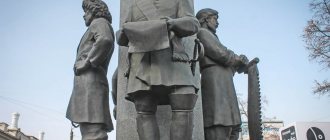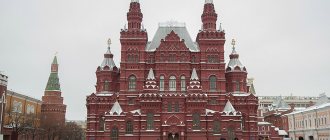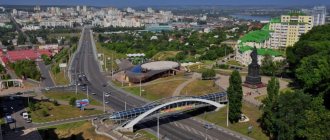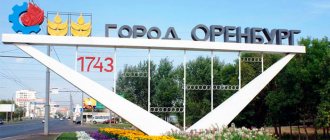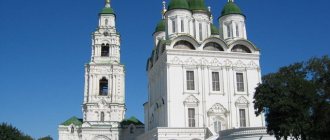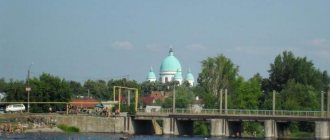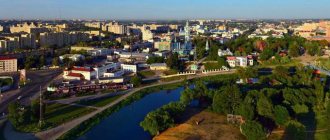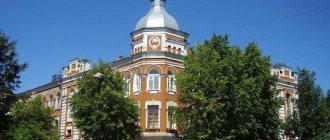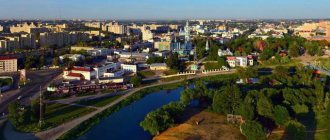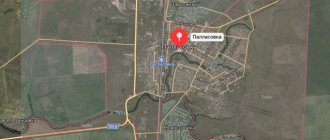| Tambov |
Tambov
, a city in Russia, the administrative center of the Tambov region and the Tambov Metropolis, the cathedral center of the Tambov diocese. Located on the Tsna River (Oka basin), 460 km southeast of Moscow. Population 283.8 thousand (2012).
- On the map: Yandex.Map, Google map
The city was founded on April 17, 1636 on the marshy, wooded banks of the Tsna River, in the place where the Studenets River merges with it. By decree of Tsar Mikhail Fedorovich, steward and governor Roman Boborykin began construction of the fortress city of Tambov to protect the Moscow state from nomads. The original name of the city was written “ Tonbov
” and was associated with the supposed site of the founding of a fortress on the Lipovitsa River “opposite the extreme Mordovian village of Tonbov” and the Tonbov River. Although the city was founded in a different place, it retained its original name. The root of the word is most likely of Moksha origin (“tonbo” - whirlpool). The fact of the founding of Tambov is reflected in an ancient chronicle written in 1788 by an unknown author.
As the borders of the Russian state moved south, Tambov by the end of the 17th century lost its former significance as a military guard fortress. In 1708, Tambov, as a district city, was assigned to the Azov province. Its connections with Moscow, the cities of the Black Earth Region and the Volga region are expanding.
In 1719, it became the center of the Tambov province, which became part of the Azov province, later (in 1732) renamed the Voronezh province. In 1779, it became the administrative center of the Tambov governorship, which in 1796 became known as the Tambov province. The province included 13 cities.
In the middle of the 19th century, the construction of stone buildings began in Tambov - a guest courtyard, government offices, a men's gymnasium and the Alexander Institute. The formation of the city center ended at the end of the 19th century with the construction of the Naryshkin reading room, the building of the State Duma and the Assembly of the Nobility.
In the 19th century, Tambov was a major center for grain wholesale trade. Industry developed slowly and in 1913 it provided only 2% of the total industrial output of European Russia. Before the October Revolution, the largest enterprises in Tambov were railway workshops (800 workers) and a candle factory (85 workers). In addition to them, there were about 30 small semi-handicraft factories.
The February and October revolutions of 1917 took place quite peacefully in Tambov.
In August 1919, during the civil war, the city was captured by the cavalry of General Mamontov. In 1920-21, the city was engulfed in a peasant uprising led by A.S. Antonov.
In 1928, the Tambov province was included in the Central Black Earth Region, and with the dissolution of the Central Black Earth Region in 1934, it was included in the Voronezh Region.
In 1937, the Tambov region was formed, which included the territory of the Penza and Tambov regions; in 1939, the boundaries of the region were revised.
During the Great Patriotic War, a large number of hospitals were opened in the city, and the city was bombed.
About the region: History of Tambov
Tambov is a Mordovian word. It means a whirlpool. Researcher of the Tambov region I.I. Dubasov says that the Tambov lands were previously inhabited by Mordovians, which is why many villages, hamlets and tracts received and now retain Mordovian names. The city of Tambov arose in 1636 as a fortified point on what used to be a “wild field” here. At the first time of its existence, Tambov actually defended the southern possessions of the Moscow state from the raids of nomads, but when the fortified line was moved further to the south, it turned into a peaceful point. Almost a hundred and fifty years after its founding, in 1779, the city of Tambov resembled a large black earth village. Almost all its houses were thatched, and the swampy streets were lined with fascinite, pitted with holes and crossed by weed mounds. Academician Falk, who visited Tambov in 1769, found that “the city is not extensive and ugly. Residents are more engaged in agriculture than crafts, however, there were two cloth factories there. There were up to 626 merchants." In the same year, Tambov was made the main city of the Tambov governorship, and 7 years later, in 1786, it received the famous poet G.R. as ruler. Derzhavina. In 1781, the coat of arms of the city of Tambov was approved - a beehive and three bees on an azure background as a symbol of hard work and beekeeping, which the inhabitants of the Tambov region have been engaged in for a long time. The development of Tambov began only at the beginning of the 19th century. At this time there were 12 thousand inhabitants. In 1872, Tambov had 25 thousand inhabitants, according to the 1897 census there were more than 48 thousand people, and on January 1, 1910 there were 68,400 people. Now (as of 1913) Tambov is a relatively good city; it has running water, electric lighting, several secondary educational institutions: two men's and three women's gymnasiums, two real schools, a teachers' institute and more than 30 other educational institutions. It is impossible not to note another Tambov governor - Alexander Alekseevich Kornilov (brother of the famous Russian admiral - hero of Sevastopol. He spent five years in this position - from February 1838 to April 1843. It was with this time that many important changes were associated that took place in life not only Tambov, but the entire region. In 1843, an institute was opened to educate the daughters of impoverished nobles. In the first year after Kornilov’s arrival in Tambov, the newspaper “Tambov Provincial News” began to be published here. In 1841, a school for education was transferred from neighboring Voronezh to Tambov clerks, and a year later the provincial zemstvo hospital was built and a building was laid for the public House of Culture. In the middle of the 19th century, the construction of stone buildings began in Tambov - the Gostiny Dvor, public places, a men's gymnasium and the Alexander Institute. The formation of the city center was completed at the end of the 19th century with the construction Naryshkin reading room, the building of the State Duma and the Assembly of the Nobility. In the 19th century, Tambov was a major center for grain wholesale trade. Industry developed slowly and in 1913 it provided only 2% of the total industrial output of European Russia. Before the October Revolution, the largest enterprises in Tambov were railway workshops (800 workers) and a candle factory (85 workers). In addition to them, there were about 30 small semi-handicraft factories. The post-revolutionary period can be described as a time of demolition of churches and construction of factories, clubs, and educational institutions. Housing construction was also carried out. Standard five- and nine-story buildings, although they did not add beauty to the appearance of the city, made it possible to some extent solve the housing problem in Tambov, which had become an industrial center. The February and October revolutions took place quite peacefully in Tambov. In 1920-21, a peasant uprising took place under the leadership of A.S. Antonova. In 1928, the Tambov province was included in the Central Black Earth Region. In 1937, the Tambov region was formed, which included the territory of the Penza and Tambov regions, and in 1939, the Tambov region adopted almost modern borders; The Great Patriotic War claimed the lives of thousands of Tambov residents and was remembered for the exhausting work, the bombing of the city, the opening of a large number of evacuation hospitals...
****************** Source “Great Soviet Encyclopedia”, 1978 :
“Tambov, city, center of the Tambov region of the RSFSR.
Pier on the left bank of the river. Tsny (Volga basin). Railway junction lines (to Michurinsk, Saratov, Kamyshin) and roads, 480 km to the south-east. from Moscow. 257 thousand inhabitants (1975; 48 thousand in 1897, 72 thousand in 1926, 106 thousand in 1939, 172 thousand in 1959, 230 thousand in 1970). The city is divided into 3 districts. Founded in 1636 as a fortress to protect the Moscow state from attacks by the Crimean and Nogai Tatars. Part of the Simbirsk defensive line. In 1670, S. T. Razin’s troops approached Tambov. Since 1719 the main city of the Tambov province, since 1779 - the Tambov governorship. Since 1796 provincial center. In 1830, a “cholera riot” occurred in Tambov; trade in grain and livestock occupied a significant place in the city’s economy; industry was represented by semi-handicraft production. In 1870, the Ryazan-Ural railway passed through Tambov. d. By 1913, about 2.4 thousand workers worked at 22 enterprises in Tambov. The first Marxist circle in Tambov arose in 1896. Soviet power was established on January 31 (February 13), 1918. During the liquidation of the anti-Soviet kulak-SR rebellion of 1920-21, the headquarters of the Soviet troops was located in Tambov. During the years of socialist construction, Tambov became a major industrial center of the RSFSR. The leading place in the industry is occupied by mechanical engineering and metalworking: production of equipment for the chemical industry (Komsomolets), components for automobile and tractor enterprises, spare parts for cars and tractors, forging and pressing machines (plants of sliding bearings, technological equipment, repair and bearing plants) , instrument making and electrical production (etc.), repair of isothermal cars. The chemical industry produces dyes, rubber and rubber-asbestos products. Production of building materials; clothing, footwear, food, furniture industries. CHP. The city is located in a gentle amphitheater at the bend of the river. Prices. In 1781, a general plan with a radial-semicircular street system was approved. Architectural monuments: Church of the Intercession (1768), Gostiny Dvor (late 18th century), summer church of the Kazan Monastery (1818). In Soviet times, large industrial and housing construction was carried out, a number of significant public buildings were erected, including: the Philharmonic Concert Hall (1967, architect V. G. Samorodov); Palace of Culture "Yubileiny" (1970), All-Union Institute of Electrification of Agriculture (1973), City Committee of the CPSU (1974) - all three according to standard projects. In 1968, a new master plan was approved, according to which three large residential areas were comprehensively created - central, western and northwestern. Monument to V. I. Lenin (bronze, granite, 1967, sculptor P. I. Bondarenko), monument to Tambov soldiers who fell in the Great Patriotic War of 1941-45 (bronze, granite, concrete, 1970, sculptors K. Ya. Malofeev and S. E. Lebedev) - both architect A. S. Kulikov. In the city: institutes - pedagogical, chemical engineering, a branch of the Moscow Institute of Culture; 11 secondary specialized educational institutions (including technical schools - motor transport, agricultural, cooperative, railway transport). All-Union Research Institute of Rubber Engineering, Research Institute of Chemicals for Polymer Materials. Theatres: drama, puppet theaters; Philharmonic. Local history museum, art gallery. There is a cardiological sanatorium in Tambov. Lit.: Shirstova Z. E., Snytko M. K., Tambov. Economic-geographical essay, M., 1962; Tambov, Voronezh, 1967." About the region Up
Foundation of the city of Tambov
By order of the sovereign of Tsar Mikhail Fedorovich, the steward and Shatsk governor Roman Boborykin goes to the Wild Field to establish a stronghold there. On April 17, 1636, Boborykin chooses a place reliably protected by nature itself from any enemy attack. It was located on a hill near the confluence of two rivers - Tsna and Studenets. A fort and the Kremlin (the city itself) were built on the hill.
The fortress was built thoroughly: the walls were cut from oak in two rows. The tied oak trunks were additionally strengthened with earthen backfill. For reinforcement, watchtowers were built. The six-meter walls seemed an impregnable barrier. To protect the city from the southern side, Boborykin ordered to dig a ditch connecting the Studenets River with Tsna. The ditch was filling with water. An additional water barrier turned the city into an island. A garrison of thousands was sent to a permanent location in the Tambov fortress. The population of the city immediately increased significantly.
To protect Muscovite Rus' from raids by the Nogais and Crimean Tatars, in addition to Tambov, a number of outposts and fortresses were built on the southern border of the state. A lot of effort was put in. The great burden of construction fell on the shoulders of the then small local population. But the efforts were worth the result: a reliable barrier stood in the way of the Tatar raids.
Development of Tambov in the first century
The built defensive fortress created the conditions for the massive resettlement of peasants here from other regions of Rus'. The population of Tambov has grown significantly in a short time. Peasants in the Tambov region sought to obtain a plot of fertile land and hide from the landowners. Their desires were partially satisfied: they received land, but feudal lords appeared in such a remote place. In 1670-1671, a peasant uprising against the oppression of the landowners took place in the Tambov region. Twice peasant detachments besieged Tambov, and both times they retreated. The uprising ended with the defeat of the rebels.
By the end of the 17th century, the city of Tambov turned into a gathering point for Russian troops to participate in the Azov campaigns. Tsar Peter I was defeated in his first campaign. This prompted the young king to quickly build a navy. Tambov peasants were mobilized to create the ships. They cut down the forest, and it was from Tambov wood that the first ships of the Russian fleet were built.
The beginning of the 18th century in the history of Tambov was marked by two main events:
1) In 1738, a new fortress was built in the city. The fire destroyed the century-old structure. And although the peasants now no longer needed the protection of the fortress or guards, the fortress wall was still erected - the threat of raids by steppe troops from the Lower Volga region and the Kuban region still existed.
2) The first educational institution was opened in Tambov. It became a garrison school for soldiers.
The population of Tambov began to increase due to increased security.
Education and employment
Despite the fact that the population of the city of Tambov is small, here you can get not only secondary education, but also higher education, since the city is considered a scientific and industrial center.
In Tambov, there are about 20 schools and gymnasiums and about 15 educational institutions where you can get secondary specialized education. For example, a teacher training college, a civil engineering college, a business college and an art college.
Higher educational institutions include four local ones, including technical and music-pedagogical universities, as well as about ten institutions that are branches of Moscow universities.
The population of Tambov is mainly employed in industry and trade. Such areas as mechanical engineering, chemical industry, chemical engineering, as well as light and food industries are developed.
In addition to employment in enterprises, people also work in research institutes of various fields, of which there are about 10. Thus, in the city there is a research institute for rubber mechanical engineering, radio engineering, etc.
Ethnic composition and religion
The population of Tambov is mainly represented by Russians, who make up about 90% of all its residents. Ukrainians, Gypsies, Tatars, and Azerbaijanis also live in the city, but their total number does not exceed 5%.
In terms of religion, most of the local residents are Orthodox, although there are also a small percentage of Catholics and Muslims. There are also people here who belong to various religious groups, whose religion is not officially recognized throughout the world (Baptists, Jehovah's Witnesses, etc.).
